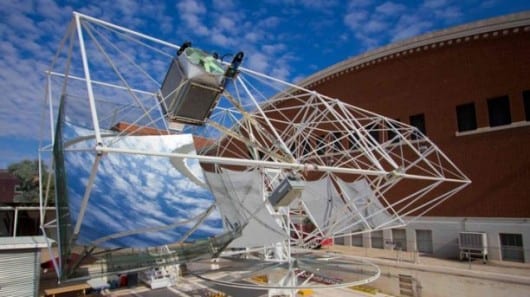The team is now looking to find new applications for this technology.
Borrowing technology from sophisticated telescope mirrors as well as high-efficiency solar cells used for space exploration, a group of students and researchers at the University of Arizona is putting the final touches on a novel power plant that promises to generate renewable energy twice as efficiently as standard solar panel technology with highly competitive costs and a very small environmental impact.
Curved mirrors in solar power plants usually concentrate the sun’s rays along a water pipe, heating the water into steam that is then fed to power-generating turbines. But rather than distributing the power over the area of a water pipe, researchers at the University of Arizona are working on focusing as much as possible of the sun’s captured energy onto a precise point in space.
The target is a small glass ball that is only five inches in diameter. The ball contains a specially coated lens that redirects the light to an array of 36 small, high-efficiency solar cells, which were originally developed for space applications, that can absorb light over a broader spectrum than standard cells. And instead of mirrors shaped like a cylinder, the team had to develop dish-shaped mirrors that focus light onto a point.
“By using mirrors to focus on small but super-efficient photovoltaic cells, we have the potential to make twice as much electricity as even the best photovoltaic panels,” Prof. Roger Angel, who is coordinating the research efforts, commented.
Because the rays concentrate on a small area, the process generates very high temperatures – so high, in fact, that they could melt the solar cells in seconds. To prevent this, the team designed an effective cooling system, a simple combination of fans and radiators that keeps the solar cells within 36° F (20° C) of the ambient air temperature.
Each module features two highly reflective, curved, 10 by 10 feet (3 x 3 m) glass mirrors mounted on a steel structure. The module automatically orients itself toward the sun for maximum performance: in the morning it turns to the east, tracks the sun’s path for the entire day and, after sunset, predicts where the sun will be rising and preps itself for the next day of clean, efficient power generation.
via Gizmag – Dario Borghino
The Latest Streaming News: solar power module updated minute-by-minute









